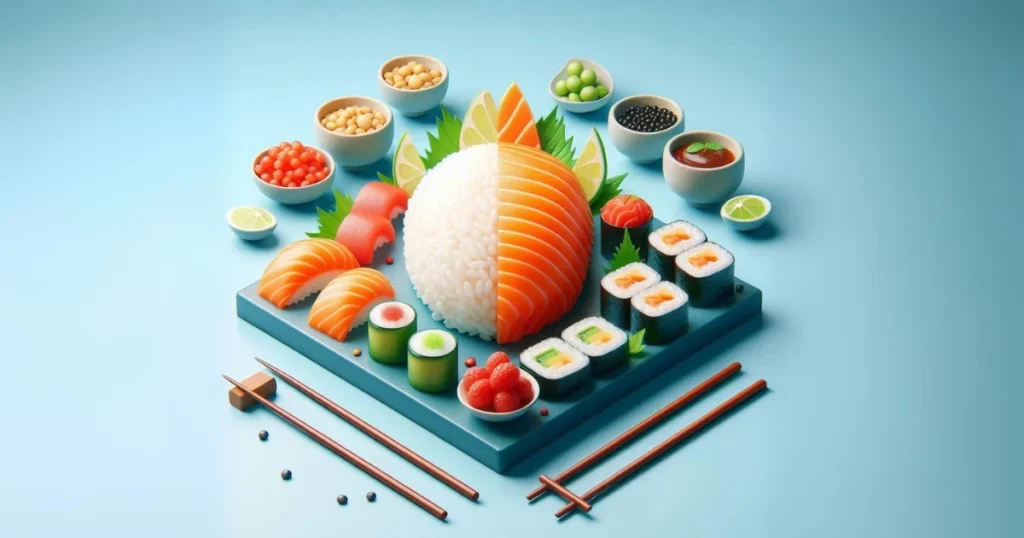
A lot of Japanese places serve both sushi and sashimi. Each is a popular Japanese traditional dish, but there are some important changes between them.
This article discusses the key similarities and differences between sushi and sashimi, including their manufacturing processes, the nutrients they contain, and how they impact your health.
Ingredients and how they’re made
When you make sushi, you mix vinegared rice with fresh vegetables or fish, wrap it in seaweed, and cut it into small, bite-sized pieces.
Sushi frequently uses raw fish, but not all sushi contains fish. You can add other things to this dish, like lettuce, avocado, sweet potato, sesame seeds, and sauces. People often serve it with pickled ginger, soy sauce, and wasabi as toppings.
Sashimi is thinly sliced raw meat or fish. Some of the most well-known kinds of sushi are salmon, tuna, halibut, and squid.
To catch fish fit for sashimi, people use a single-hand line instead of a net. They immediately kill the fish and place it on ice to prolong its freshness.
Unlike sushi, sashimi does not come with rice, sauces, or toppings.
Nutritional differences between sushi vs. sashimi
The nutrients in sushi depend on the types of ingredients used, but because it has rice, seaweed, and veggies, it usually has more carbs and fiber than sashimi.
On the other hand, sashimi is a better source of energy and heart-healthy fats because it only has raw meat or fish. The table below shows how 100 grams (3.5 ounces) of sushi and fish stack up.
| California sushi roll | Smoked salmon sashimi | |
| Calories | 93 | 179 |
| Protein | 3 grams | 21.5 grams |
| Fat | 1 gram | 11 grams |
| Carbs | 18.5 grams | 0 grams |
| Fiber | 1 gram | 0 grams |
The above-mentioned famous California roll usually has crab or fake crab, cucumber, and avocado.
Remember that most people eat more sushi than sashimi in a single dish, which could change the total amount of nutrients you take in.
No matter what, sushi has more protein. This nutrient is essential for tissue repair, wound healing, and muscle building. According to research, eating more protein-rich foods, such as sashimi, may help you control your hunger and feel less hungry.
It also has more good fats, like omega-3 fatty acids, which help keep your heart healthy and reduce inflammation.
Downsides to eating sushi and sashimi?
Sushi is more versatile and fits more diets than other foods.
For instance, people who are vegetarian or don’t like fish can still eat sushi rolls made with cucumber or avocado, but they can’t eat sashimi, which is made with only raw meat or seafood.
For some people, however, sushi may cause their blood sugar and blood pressure to rise because it is high in refined carbs and salt.
Additionally, raw fish is a common ingredient in sashimi and many other types of sushi, posing numerous safety risks. Consuming raw fish may increase your risk of illness due to its potential contamination with harmful parasites and bacteria.
People often advise pregnant women, children, and older adults to avoid raw fish at all costs.
In addition, some fish species contain high levels of heavy metals such as mercury, a poison that has been associated with numerous health issues.
Frequently Asked Questions
1. Is sushi, or sashimi, healthier?
A. Both have their benefits. Sushi offers a more diverse range of nutrients due to its varied ingredients, while sashimi is a purer, lower-calorie source of high-quality protein and omega-3s
2. Can you eat sushi or sashimi every day?
A. While both can be part of a healthy diet, it’s important to be mindful of mercury levels in fish and ensure that the raw fish is fresh and handled properly to avoid foodborne illnesses.
3. What are the best fish choices for sashimi?
A. Popular choices include tuna, salmon, yellowtail, and mackerel due to their flavor and texture.
4. Is there a risk of mercury poisoning with sushi or sashimi?
A. Certain fish, like tuna, can have higher levels of mercury. It’s best to consume these in moderation and vary the types of fish you eat.
The bottom line
Even though both sushi and sashimi are popular Japanese foods, they are not the same thing at all.
A variety of fresh toppings and vinegared rice combine to make sushi. It’s usually cut up and wrapped in seaweed. On the other hand, sashimi is thinly sliced raw meat or fish.
Sushi is a better food choice than sashimi because vegetarians and vegans can eat forms made without fish. It does, however, have more refined carbs and salt, as well as less protein and heart-healthy fats.
Note that eating raw fish can make you sick, and some seafood may be high in heavy metals. As a result, you should only eat small amounts of sashimi and sushi with raw fish.


